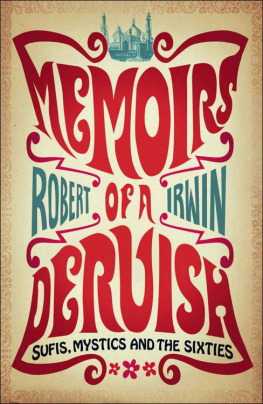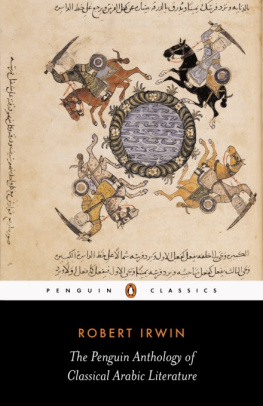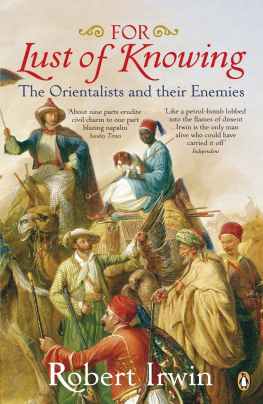THE ALHAMBRA
Robert Irwin lives in London. His fiction includes The Arabian Nightmare (1983) and Exquisite Corpse (1995). His many books and articles on Islamic subjects include The Arabian Nights: A Companion (1994), Islamic Art (1997) and Night & Horses & the Desert: An Anthology of Classical Arabic Literature.
He is a Fellow of the Royal Society of Literature and a Fellow of the London Institute of Pataphysics.
Irwin is a brilliant Arab scholar and a storyteller. The Alhambra, aimed at scholar and tourist alike, is a must for anyone visiting Moorish Spain. Times Higher Education Supplement
This highly readable study provides both a welcome demystification and a fascinating reinterpretation The Scotsman
Essential reading not only for tourists to Andalusia but for all those misguided enough to take a Robert Kilroy-Silk view of the major Arab contributions to civilisation. Daily Mail
This fascinating book provokes and challenges Scotland on Sunday
a lively, yet clear-headed introduction encouraging a more thoughtful and critical approach to the monument. Literary Review
This book captures and conveys the mysterious attractions of the Alhambra. Doris Lessing
a fascinating and very manageable guide Daily Telegraph
he brings the majestic ruins to life Newsweek
[a] delicious, tart monograph Independent on Sunday
fascinating Sunday Times
ALSO BY ROBERT IRWIN
The Middle East in the Middle Ages:
the Early Mameluke Sultanate 12501382
The Arabian Nights: a Companion
Islamic Art
Night and Horses and the Desert:
an Anthology of Classical Arabic Literature
Also six novels, the most recent of which is
Satan Wants Me
WONDERS OF THE WORLD
THE ALHAMBRA
ROBERT IRWIN


This paperback edition published in 2005
First published in Great Britain in 2004 by
Profile Books Ltd
58A Hatton Garden
London ECIN 8LX
www.profilebooks.co.uk
Copyright Robert Irwin, 2004, 2005
1 3 5 7 9 10 8 6 4 2
Typeset in Caslon by MacGuru Ltd
info@macguru.org.uk
Designed by Peter Campbell
Printed and bound in Great Britain by
Bookmarque Ltd, Croydon, Surrey
The moral right of the author has been asserted.
All rights reserved. Without limiting the rights under copyright reserved above, no part of this publication may be reproduced, stored or introduced into a retrieval system, or transmitted, in any form or by any means (electronic, mechanical, photocopying, recording or otherwise), without the prior written permission of both the copyright owner and the publisher of this book.
A CIP catalogue record for this book is available from the
British Library.
ISBN 1 86197 487 6
CONTENTS
CHRONOLOGY
711 | Arabs enter Spain. |
755 | Abd al-Rahman I establishes Umayyad emirate in Spain. |
c.880s | The first version of the Alcazaba, or citadel of the Alhambra, built. |
928 | The Umayyad Abd al-Rahman III takes the title of Caliph. |
936 | Foundation of the Umayyad Palace of Madinat al-Zahra outside Cordova. |
1013 | Sack of Umayyad Cordova. |
1031 | End of the Umayyad dynasty and beginning of the age of Taifa or Petty Kings. |
1085 | Fall of Muslim Toledo to Christian Castile. |
1230 | Ibn al-Ahmar establishes Nasrid rule over Granada and becomes the last Muslim ruler in Spain. |
c.1320s | Building of the first version of the Mexuar. |
133354 | Reign of Nasrid Yusuf I over Granada. During his reign the Comares Palace is built. |
13549 | First reign of Muhammad V (followed by exile in Morocco). |
136291 | Second reign of Muhammad V. Additions to the Comares Palace and the building of the Court of the Lions. |
1368 | Muhammad V conquers Algeciras. |
1369 | Death of Pedro the Cruel. |
1374 | Murder of Ibn al-Khatib in Fez. |
1392 | Murder of Ibn Zamrak in Granada. |
c.1450s | Building of the Tower of the Princesses. |
1492 | Fall of Granada to Ferdinand and Isabella and the surrender of the last Muslim territory in Spain. |
1526 | Arrival of Charles V in Granada and commencement of work on his palace. |
INTRODUCTION
The Alhambra is Spains best-kept secret. This glorious medieval palace, which resembles a childs toy castle, sits on the Assabica hills. (Assabica is Arabic for red.) The palace was built in the years 133491 and was the seat of the magnificent Nasrid caliphs. What stories this building could tell if only it could speak! Despite the austerity of the palaces outward appearance, its immaculately restored interior more closely resembles a ladys boudoir. However, there are no statues or figurative paintings in the palace, as Islam strictly forbids images of any kind. Like Hittite and Ottoman palaces, the palace of the Alhambra was divided into three sections. First, there was the Mexuar, the chamber where public business was transacted. Members of the public could penetrate no further into the palace than the Mexuar. At the end of the Mexuar is a small private chapel that was built by the Catholic monarchs, Ferdinand and Isabella, after they conquered the palace in 1492. Beyond the Mexuar, there was the Court of the Myrtles where more private administrative business was conducted and where ambassadors were received. (It was in the Hall of the Ambassadors that Columbus presented his scheme to cross the Atlantic to the Catholic monarchs of Aragon and Castile.) The goldfish pool is the central pivot of the Court of the Myrtles.
Finally, the private apartments of the king and his wives andconcubines were located in the Court of the Lions. Off the Court of the Lions, one enters the Hall of the Two Sisters, which was the private apartment of the kings favourite concubine of the moment. (Note its trompe-loeil ceiling.) The Lindaraxa chamber that leads off it was the dressing room of the favourite. Then there is the Gossip Room, which was a factory of intrigue. Finally, do not miss the Hall of the Kings and its celebrated dancing room. This was also the place where great roistering feasts were held. Though the Court of the Lions was home to the royal harem, its eunuch guards did not guard it carefully enough. In the Hall of the Abencerrages (and here note another trompe-loeil ceiling based on a theorem by Pythagoras), the Sultan Boabdil, having invited thirty-nine members of the Abencerrage clan to dinner, had them all slaughtered, after he had discovered that one of them had been having an affair with his favourite concubine, Zorayda. The struggle for the affections of Zorayda led directly to the fall of Granada to the Christians in 1492. The paintings on the ceiling of the nearby Hall of the Kings were done by a Spanish Christian painter and depict historical scenes. The Lion Fountain, that gives this part of the palace its name, was originally made for a Jewish palace of the eleventh century, but subsequently it had its Jewish imagery erased and Muslim motifs were substituted. The twelve lions, that support the fountain and leer at the tourists, symbolise the twelve signs of the zodiac and the four water channels that cross the courtyard represent the four rivers of paradise. After 1492 the palace fell into dilapidation, but during the Peninsular War, the Duke of Wellington chased out the chickens, beggars and gypsies and made his home in the Alhambra. He also planted elm trees all the way down the slopes of the Alhambra hill. Conclude your tour by visiting the Generalife (Arabic for Garden of the Architect), which was the Nasrid
Next page












